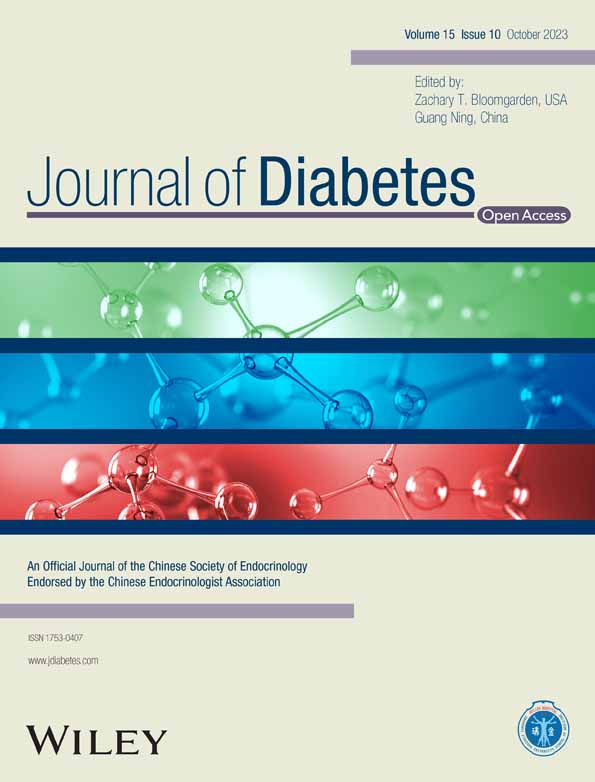Sensitivity to thyroid hormone and risk of components of metabolic syndrome in a Chinese euthyroid population
中国甲状腺功能正常人群对甲状腺激素的敏感性和代谢综合征组分的风险
Abstract
enIntroduction
To evaluate the association of sensitivity to thyroid hormone with metabolic syndrome (MetS) and its components in a Chinese euthyroid population.
Methods
A total of 3573 participants from Pinggu Metabolic Disease Study were analyzed. Serum-free triiodothyronine (FT3), free thyroxine (FT4), thyrotropin (TSH), total adipose tissue (TAT), visceral adipose tissue (VAT), subcutaneous adipose tissue (SAT) area of abdominal, and lumbar skeletal muscle area (SMA) were measured. Central thyroid hormone resistance was calculated by the Thyroid Feedback Quantile-based Index (TFQI) and Chinese-referenced Parametric TFQI (PTFQI), Thyrotroph T4 Resistance Index (TT4RI) and TSH Index (TSHI). Peripheral thyroid hormone resistance was assessed by FT3/FT4 ratio.
Results
Higher values of TSHI (odds ratio [OR] = 1.167, 95% confidence interval [CI]: 1.079–1.262, p < .001), TT4RI (OR = 1.115, 95% CI: 1.031–1.206, p = .006), TFQI (OR = 1.196, 95% CI: 1.106–1.294, p < .001), PTFQI (OR = 1.194, 95% CI: 1.104–1.292, p < .001), and lower values of FT3/FT4 ratio (OR = 0.914, 95% CI: 0.845–0.990, p = .026) were associated with MetS. Increased levels of TFQI and PTFQI were associated with abdominal obesity, hypertriglyceridemia, and hypertension. Increased levels of TSHI and TT4RI were associated with hypertriglyceridemia, abdominal obesity, low high-density lipoprotein cholesterol. Reduced levels of FT3/FT4 ratio were associated with hyperglycemia, hypertension, and hypertriglyceridemia. The levels of TSHI, TFQI, and PTFQI were negatively related to SMA and positively related to VAT, SAT, and TAT (all p < .05).
Conclusions
Reduced thyroid hormone sensitivity was associated with MetS and its components. Impaired thyroid hormone sensitivity might affect the distribution of adipose tissue and muscle.
摘要
zh目的: 评估甲状腺功能正常人群中甲状腺激素敏感性与中国代谢综合征(MetS)及其组分的关系。
方法: 对平谷代谢性疾病研究中的3573名参与者进行分析。测量血清游离三碘甲状腺原氨酸(FT3)、游离甲状腺素(FT4)和促甲状腺激素(TSH),计算腹部及腰部骨骼肌面积、内脏脂肪组织(VAT)、皮下脂肪组织(SAT)和全身脂肪面积(TAT),通过甲状腺反馈量化的甲状腺激素抵抗指数(TFQI)、基于中国参考参数的参数TFQI(PTFQI)、促甲状腺素T4抵抗指数(TT4RI)以及TSH指数(TSHI),计算周围甲状腺激素抵抗,即FT3/FT4比值。
结果: 较高的TSHI(OR=1.167,95%CI: 1.079,1.262,p<0.001)、TT4RI(OR=1.115,95%CI: 1.031,1.206,p=0.006)、TFQI(OR=1.196,95%CI: 1.106,1.294,p<0.001)、PTFQI(OR=1.194,95%CI: 1.104,1.292,p<0.001)以及较低的FT3/FT4比值(OR=0.914,95%CI: 0.845,0.990,p=0.026)与MetS相关。TFQI和PTFQI水平的升高与腹部肥胖、高三酰甘油血症和高血压相关。TSHI和TT4RI水平的升高与高三酰甘油血症、腹部肥胖、低高密度脂蛋白胆固醇(HDL-C)相关。FT3/FT4比值的降低与高血糖、高血压和高三酰甘油血症相关。TSHI、TFQI和PTFQI水平与SMA呈负相关,与VAT、SAT和TAT呈正相关(均p<0.05)。
结论: 甲状腺激素敏感性的降低与MetS及其组分相关。甲状腺激素敏感性的降低可能影响脂肪组织的分布和肌肉的改变。
CONFLICT OF INTEREST STATEMENT
No potential conflicts of interest relevant to this article were reported.
Open Research
DATA AVAILABILITY STATEMENT
No additional data available.




